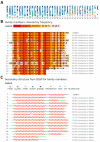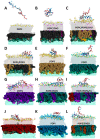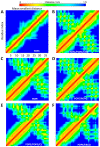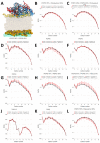Molecular Basis of the Anticancer and Antibacterial Properties of CecropinXJ Peptide: An In Silico Study
- PMID: 33445613
- PMCID: PMC7826669
- DOI: 10.3390/ijms22020691
Molecular Basis of the Anticancer and Antibacterial Properties of CecropinXJ Peptide: An In Silico Study
Abstract
Esophageal cancer is an aggressive lethal malignancy causing thousands of deaths every year. While current treatments have poor outcomes, cecropinXJ (CXJ) is one of the very few peptides with demonstrated in vivo activity. The great interest in CXJ stems from its low toxicity and additional activity against most ESKAPE bacteria and fungi. Here, we present the first study of its mechanism of action based on molecular dynamics (MD) simulations and sequence-property alignment. Although unstructured in solution, predictions highlight the presence of two helices separated by a flexible hinge containing P24 and stabilized by the interaction of W2 with target biomembranes: an amphipathic helix-I and a poorly structured helix-II. Both MD and sequence-property alignment point to the important role of helix I in both the activity and the interaction with biomembranes. MD reveals that CXJ interacts mainly with phosphatidylserine (PS) but also with phosphatidylethanolamine (PE) headgroups, both found in the outer leaflet of cancer cells, while salt bridges with phosphate moieties are prevalent in bacterial biomimetic membranes composed of PE, phosphatidylglycerol (PG) and cardiolipin (CL). The antibacterial activity of CXJ might also explain its interaction with mitochondria, whose phospholipid composition recalls that of bacteria and its capability to induce apoptosis in cancer cells.
Keywords: antibiotic resistance; anticancer; antimicrobial peptide; biophysics; esophageal carcinoma; molecular dynamics; sequence alignment.
Conflict of interest statement
The authors declare that they have no competing interests.
Figures







Similar articles
-
Molecular basis of the anticancer, apoptotic and antibacterial activities of Bombyx mori Cecropin A.Arch Biochem Biophys. 2022 Jan 15;715:109095. doi: 10.1016/j.abb.2021.109095. Epub 2021 Nov 24. Arch Biochem Biophys. 2022. PMID: 34826396
-
Bombyx mori Cecropin D could trigger cancer cell apoptosis by interacting with mitochondrial cardiolipin.Biochim Biophys Acta Biomembr. 2022 Oct 1;1864(10):184003. doi: 10.1016/j.bbamem.2022.184003. Epub 2022 Jul 16. Biochim Biophys Acta Biomembr. 2022. PMID: 35850261
-
Antimicrobial Peptide K11 Selectively Recognizes Bacterial Biomimetic Membranes and Acts by Twisting Their Bilayers.Pharmaceuticals (Basel). 2020 Dec 22;14(1):1. doi: 10.3390/ph14010001. Pharmaceuticals (Basel). 2020. PMID: 33374932 Free PMC article.
-
Antimicrobial Peptides as Anticancer Agents: Functional Properties and Biological Activities.Molecules. 2020 Jun 19;25(12):2850. doi: 10.3390/molecules25122850. Molecules. 2020. PMID: 32575664 Free PMC article. Review.
-
Structure and dynamics of phospholipids in membranes elucidated by combined use of NMR and vibrational spectroscopies.Biochim Biophys Acta Biomembr. 2020 Sep 1;1862(9):183352. doi: 10.1016/j.bbamem.2020.183352. Epub 2020 May 11. Biochim Biophys Acta Biomembr. 2020. PMID: 32407775 Review.
Cited by
-
The characteristics and roles of antimicrobial peptides as potential treatment for antibiotic-resistant pathogens: a review.PeerJ. 2021 Dec 14;9:e12193. doi: 10.7717/peerj.12193. eCollection 2021. PeerJ. 2021. PMID: 35003909 Free PMC article.
-
Peptides for Health Benefits 2020.Int J Mol Sci. 2022 Jun 16;23(12):6699. doi: 10.3390/ijms23126699. Int J Mol Sci. 2022. PMID: 35743143 Free PMC article.
-
Mechanistic Understanding from Molecular Dynamics in Pharmaceutical Research 2: Lipid Membrane in Drug Design.Pharmaceuticals (Basel). 2021 Oct 19;14(10):1062. doi: 10.3390/ph14101062. Pharmaceuticals (Basel). 2021. PMID: 34681286 Free PMC article. Review.
-
Charge, Hydrophobicity, and Lipid Type Drive Antimicrobial Peptides' Unique Perturbation Ensembles.Biochemistry. 2025 Apr 1;64(7):1484-1500. doi: 10.1021/acs.biochem.4c00452. Epub 2025 Mar 19. Biochemistry. 2025. PMID: 40105792
-
The Influence of Short Motifs on the Anticancer Activity of HB43 Peptide.Pharmaceutics. 2022 May 19;14(5):1089. doi: 10.3390/pharmaceutics14051089. Pharmaceutics. 2022. PMID: 35631675 Free PMC article.
References
MeSH terms
Substances
Grants and funding
LinkOut - more resources
Full Text Sources
Other Literature Sources
Medical

